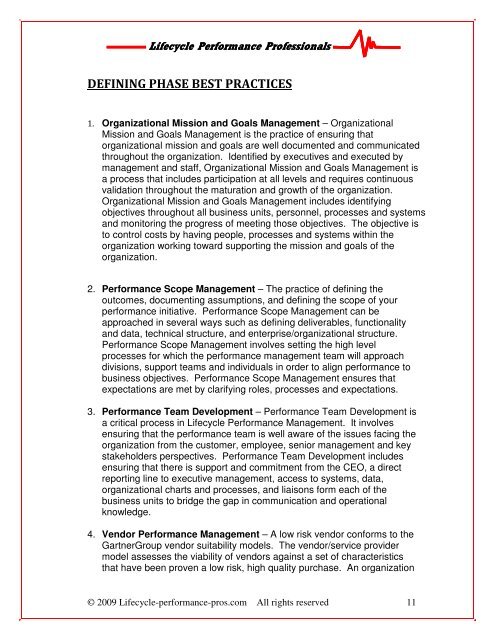Download the Performance Management Fundamentals Guide
Download the Performance Management Fundamentals Guide
Download the Performance Management Fundamentals Guide
Create successful ePaper yourself
Turn your PDF publications into a flip-book with our unique Google optimized e-Paper software.
Lifecycle Lifecycle <strong>Performance</strong> <strong>Performance</strong> Professionals<br />
Professionals<br />
DEFINING PHASE BEST PRACTICES<br />
1. Organizational Mission and Goals <strong>Management</strong> – Organizational<br />
Mission and Goals <strong>Management</strong> is <strong>the</strong> practice of ensuring that<br />
organizational mission and goals are well documented and communicated<br />
throughout <strong>the</strong> organization. Identified by executives and executed by<br />
management and staff, Organizational Mission and Goals <strong>Management</strong> is<br />
a process that includes participation at all levels and requires continuous<br />
validation throughout <strong>the</strong> maturation and growth of <strong>the</strong> organization.<br />
Organizational Mission and Goals <strong>Management</strong> includes identifying<br />
objectives throughout all business units, personnel, processes and systems<br />
and monitoring <strong>the</strong> progress of meeting those objectives. The objective is<br />
to control costs by having people, processes and systems within <strong>the</strong><br />
organization working toward supporting <strong>the</strong> mission and goals of <strong>the</strong><br />
organization.<br />
2. <strong>Performance</strong> Scope <strong>Management</strong> – The practice of defining <strong>the</strong><br />
outcomes, documenting assumptions, and defining <strong>the</strong> scope of your<br />
performance initiative. <strong>Performance</strong> Scope <strong>Management</strong> can be<br />
approached in several ways such as defining deliverables, functionality<br />
and data, technical structure, and enterprise/organizational structure.<br />
<strong>Performance</strong> Scope <strong>Management</strong> involves setting <strong>the</strong> high level<br />
processes for which <strong>the</strong> performance management team will approach<br />
divisions, support teams and individuals in order to align performance to<br />
business objectives. <strong>Performance</strong> Scope <strong>Management</strong> ensures that<br />
expectations are met by clarifying roles, processes and expectations.<br />
3. <strong>Performance</strong> Team Development – <strong>Performance</strong> Team Development is<br />
a critical process in Lifecycle <strong>Performance</strong> <strong>Management</strong>. It involves<br />
ensuring that <strong>the</strong> performance team is well aware of <strong>the</strong> issues facing <strong>the</strong><br />
organization from <strong>the</strong> customer, employee, senior management and key<br />
stakeholders perspectives. <strong>Performance</strong> Team Development includes<br />
ensuring that <strong>the</strong>re is support and commitment from <strong>the</strong> CEO, a direct<br />
reporting line to executive management, access to systems, data,<br />
organizational charts and processes, and liaisons form each of <strong>the</strong><br />
business units to bridge <strong>the</strong> gap in communication and operational<br />
knowledge.<br />
4. Vendor <strong>Performance</strong> <strong>Management</strong> – A low risk vendor conforms to <strong>the</strong><br />
GartnerGroup vendor suitability models. The vendor/service provider<br />
model assesses <strong>the</strong> viability of vendors against a set of characteristics<br />
that have been proven a low risk, high quality purchase. An organization<br />
© 2009 Lifecycle-performance-pros.com All rights reserved 11










